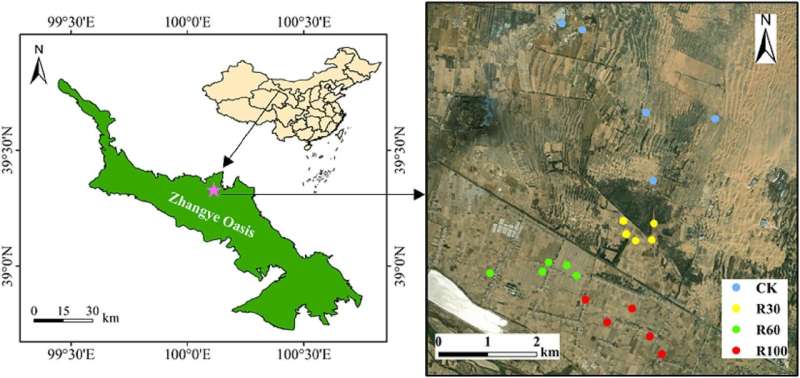This article has been reviewed according to Science X's editorial process and policies. Editors have highlighted the following attributes while ensuring the content's credibility:
fact-checked
trusted source
proofread
Study reveals changes in soil carbon and nutrient stocks in desert oasis farmland

The arid desert oasis is an important agricultural production base in northwestern China, and desert reclamation is the main reason for its continuous expansion. However, the effects of long-term conventional agricultural practices on soil carbon and nutrient pools after desert reclamation in arid oasis farmlands are still unclear.
A research team from the Northwest Institute of Eco-Environment and Resources of the Chinese Academy of Sciences investigated carbon and nutrient storage in farmland soils in the Zhangye Oasis with different reclamation ages. They used regression analysis to reveal patterns of change in carbon and nutrient storage over conventional farming years, and analyzed the key factors influencing these storage levels using a random forest model.
The study is published in Geoderma.
The researchers found that the soil carbon pool in the 0–40 cm layer increased by 4.2-fold after desert reclamation, while nitrogen and phosphorus stocks increased by 1.2–6.5-fold. However, regression analyses showed an exponential pattern of change in both carbon and nutrient stocks with years of cultivation.
In addition, carbon and nitrogen stocks in the 0–40 cm soil layer and phosphorus stocks in the topsoil layer, stopped increasing after 60 years of conventional cultivation.
The researchers also found that soil stoichiometry, pH, and mechanical composition were the key factors influencing carbon and nutrient pools in oasis farmland.
This study highlighted that despite significant improvement in soil quality after desert reclamation, the long-term effectiveness of this improvement is limited by conventional management practices.
Therefore, conventional management system of oasis farmland in arid regions should incorporate appropriate conservation tillage practices to ensure sustainable soil production.
More information: Dengke Ma et al, Long-term conventional cultivation after desert reclamation is not conducive to the improvement of soil carbon pool and nutrient stocks, a case study from northwest China, Geoderma (2024). DOI: 10.1016/j.geoderma.2024.116893
Provided by Chinese Academy of Sciences





















